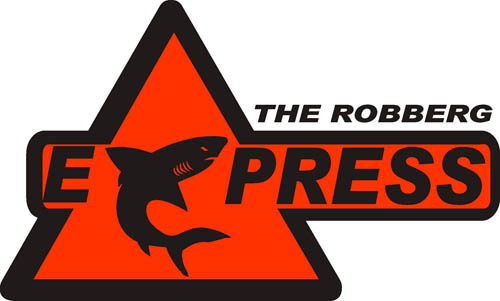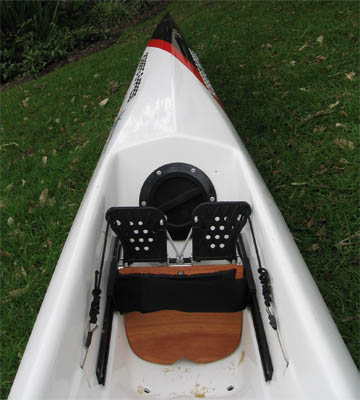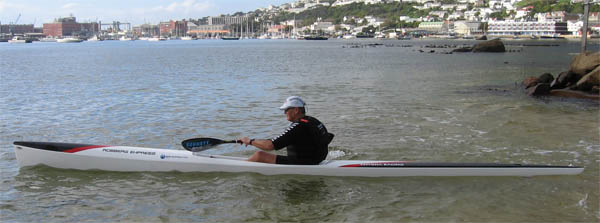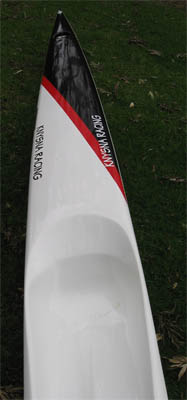Review: Updated Robberg Express
Surfski.info last reviewed the Knysna Kayaks Robberg Express in April 2006 and at the time we had a couple of reservations about the ski -in particular, in choppy water the cockpit filled with water. I've spent the last few weekends paddling the updated model and found it much improved.

Knysna Kayaks
Knysna Kayaks is based in Knysna, South Africa and are better known for their K1s and K2s. Their reputation for high quality is such that they are the sole licenced manufacturers of Vajda racing kayaks in South Africa.
Robberg Express: First Impressions
The build quality is excellent: the gelcoat has scarcely a ripple (not surprising since they now vacuum bag all their skis) and the paint scheme on our demo boat looks smart.

For a larger image, click here.
The cockpit rails have been lifted in front of the sitting position and meet a raised deck - taking away the bulbous nose that gave the original ski a rather ugly look; although the ski still looks distinctive, I much prefer the new shape.
The adjustable rudder pedals have a very smooth and easy to use mechanism. The footplate moves easily and the pedals are self adjusting. The rudder lines are made from stainless steel cable - a section of line attaches to the cable and goes through the self adjusting mechanism on each pedal. The lines come with plenty of spare - enough to make a jury rig in case of failure. (This is a good thing: last season in the course of some 25 downwind runs we saw several rudder line failures including both steel cables and V10 rudder lines.)

Paddling the ski
I paddled the ski on several occasions in different conditions:
- Downwind on our favourite Millers Run.
- On flat calm conditions in a race
- For a three hour training paddle around Robben Island during which we had some small runs on the way out and a cross-chop on the way back.
- Downwind from Fish Hoek to Buffels Bay, the so-called "reverse Millers Run".

Comfort
The importance of getting the rudder pedal adjustment right was driven home to me on our first paddle - the downwind run. I set the ski up on shore but once on the water realised that I'd set the leg length too long. I was able to change it on the water - but inadvertently set it too short. There were two consequences - the ski felt quite twitchy and my coccyx was rubbed raw.
On subsequent paddles I had the adjustment just right (calves just touching the cockpit bottom when my leg was at full stretch) and this made a huge difference to my stability and also to the state of my backside.
In short - this is one of the most comfortable skis I've paddled.
Stability/Seating Position
I find the Robberg Express very similar to the Mako6 - in which I spend most of my paddling time. The seat position is higher than the Mako6 however; your feet are below your bum and I think this adds to the comfort of the ski.

Adjustable Footplate and Rudder Pedals
The footplate assembly is held in position by two spring-loaded pins that impinge rails mounted on either side of the single footwell. A short cable is attached between the pins - you simply pull on the cable to move the rudder assembly. This is the same mechanism used on the Epic, Fenn Mako6 and Honcho skis. The pedals self adjust on the rudder lines making it extremely easy to change the set up - even while sitting in the ski on the water.
The footplate on the demo ski is built of marine ply - and felt extremely solid. "The footrest is available in carbon," Albert Wasserman, Knysna Kayak's factory manager confirmed, "but I prefer the wood."
Performance
As we all know, "it's not the hull, it's the engine". My impressions were however that:
- The ski catches waves very readily. I found that it accelerated easily onto both large and small waves. It was very controllable and did not have an undue tendency to broach.
- I found the ski's stability such that I could focus on keeping my rhythm even on choppy water.
- The position of the seat and the narrowness of the hull at the catch make the stroke comfortable and presumably efficient.
In the race that I paddled, I was beaten by my buddy Dale Lippstreu on a V10 Ultra while I beat my other regular training partner Damian Feuilherade who was on a glass Mako6. Of course a sample of one race doesn't make for accurate conclusions but for me the point was that I didn't feel that the ski was the cause of Dale beating me! I don't think there's anything wrong with the hull speed. (The Robberg Express is about 30cm shorter than the V10/Mako6 and one would expect perhaps that this would have a consequence - longer hulls are, as we all know, faster.)
Why "Robberg Express"?
I was on the beach stretching before setting out and total stranger walked up to me and said, "That's a cheeky name for a boat!" I asked why and she said, "It's the name of a huge shark that lives up the coast near Knysna!"
Albert confirmed the story: "The shark is a female of over 7 meters and is often seen off Robberg - from there its name - some tourist took a picture of the late Daniel Conradie and his partner - I think it was Jenette Walder on a double ski off Robberg - whilst the shark passed under them - it was larger than the ski!!"
Build Choices and Weights
Albert said that the normal weight of the ski is max 17kg - and without the storage compartment around 16kg.
"We also do epoxy lay-ups," he added. "14 kg in glass and 12 in carbon."
What I liked
- The build quality: the demo ski has an excellent finish. I also prefer the look of the new deck shape.
- The stability: more or less the same as a Mako6, I'd be happy to take the ski into any kind of chop
- The seating position: with bum above heels, it's one of the most comfortable cockpits I've ever sat in.
- Handling in waves: seemed to accelerate easily onto small and large waves, didn't dig the nose in, manoeuvred well and didn't broach excessively
What I didn't like
- In spite of the ski being much drier than the old one (I think I flooded the cockpit just once during our 20km downwind paddle) I still felt wet because the rails at the back of the cockpit are low. But this really is a minor issue and probably noticeable only because of the water temperature here in Cape Town! (And in any case if they did raise the rails right there, it might make the ski more difficult to remount!)
Conclusion
I really like this ski and I'd be happy to take it out (and to race it) in any weather conditions.
For more info:

